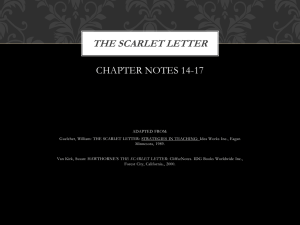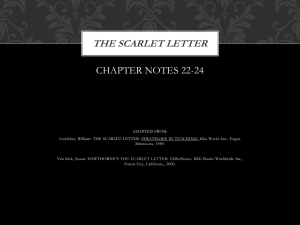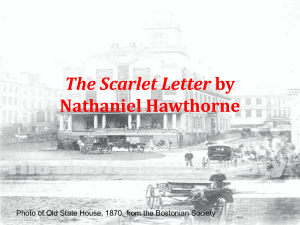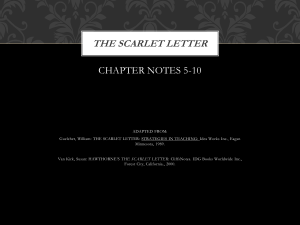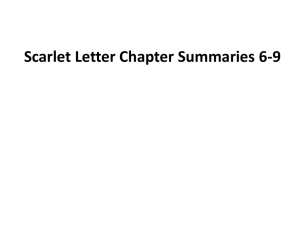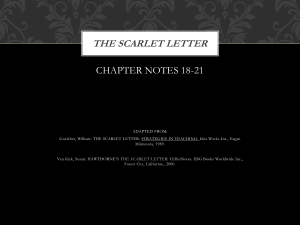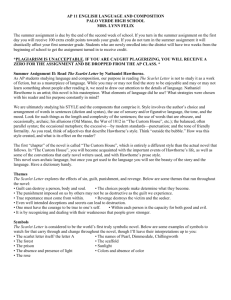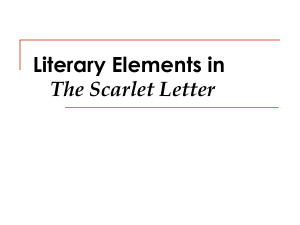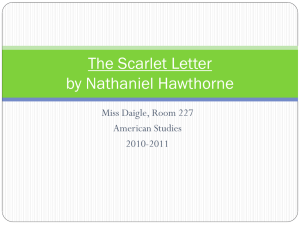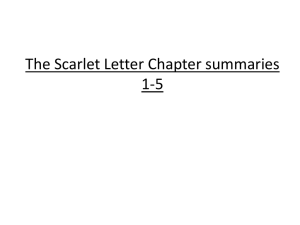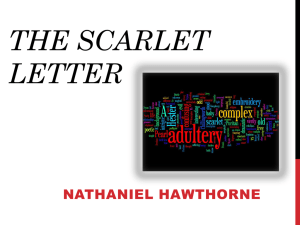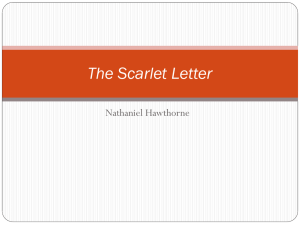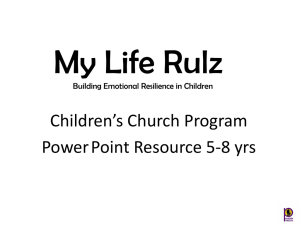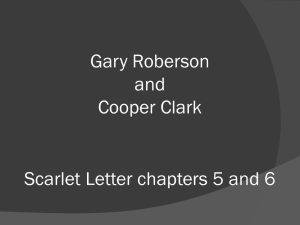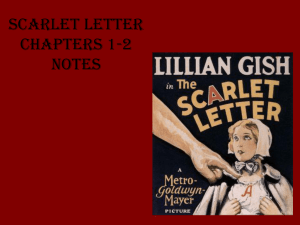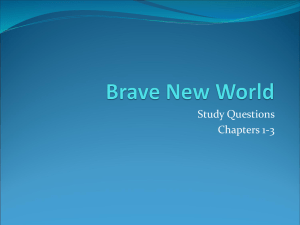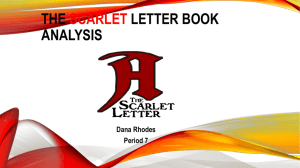Chapters 1-4 - Wayzata Public Schools
advertisement
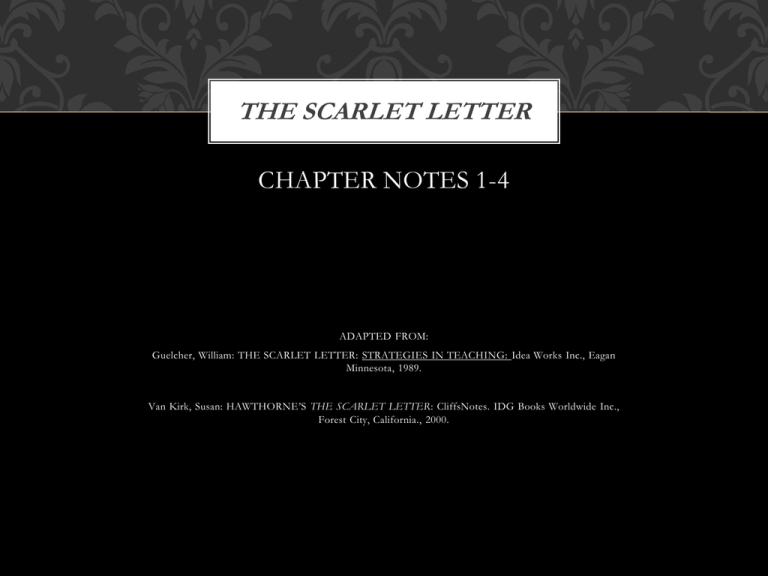
THE SCARLET LETTER CHAPTER NOTES 1-4 ADAPTED FROM: Guelcher, William: THE SCARLET LETTER: STRATEGIES IN TEACHING: Idea Works Inc., Eagan Minnesota, 1989. Van Kirk, Susan: HAWTHORNE’S THE SCARLET LETTER: CliffsNotes. IDG Books Worldwide Inc., Forest City, California., 2000. CHAPTERS 1-4 • The rose bush: “It may serve, let us hope, to symbolize some sweet moral blossom, that may be found along the track, or relieve the darkening close of a tale of human frailty and sorrow.” • What does it represent? How does it provide contrast to the surroundings (the prison, weeds) • What is the prison compared to? • What might its location outside the prison door represent? CHAPTERS 1-4 Note, too, that while the colony is still young, already the prison appears old. The “New Jerusalem” already has experienced enough sinful behavior that it felt compelled to isolate the “sinners” from the “saved.” CHAPTERS 1-4 How is Hester physically described? Name two traits or emotions she has or feels. We see two physical symbols of Hester’s sin. What are they? What is Pearl a product of ? CHAPTERS 1-4 • What is the purpose of the scaffold? • Two notable landmarks: the prison and the cemetery • All societies succumb to two realities: sin and death/destiny CHAPTERS 1-4 What is the most noticeable aspect of the scarlet “A’? What other red symbol have we seen so far? Red is associated with Hester’s sin, but remember Hawthorne’s take on the rose bush among the gloomy surroundings: “a token that the deep heart of Nature could pity and be kind to” prisoners entering and exiting the prison door. CHAPTERS 1-4 • Let’s re-read the first paragraph of Chapter 2 • What seems to be the consensus about Puritan character? This reveals Hawthorne’s critical view of Puritan society. The pious women who condemn Hester are frightening Even the kinder, younger woman has brought her child to witness the punishment. Hawthorne alludes to one of the absurdities of Puritan culture: In this absolutist mindset, all sins are treated equally. The disciplining of an unruly child would be treated with the same solemnity as hanging a witch. CHAPTERS 1-4 • A lot of symbolism in Chapter 2 • The town crier (beadle) walks with staff symbolic of religious authority: He is described as “grim and grisly,” much like the atmosphere and society. CHAPTERS 1-4 Note, too: “Had there been a Papist among the crowd of Puritans, he might have seen in this beautiful woman...with the infant at her bosom…an object to remind him of the image of the Divine Maternity.” In comparing Hester and her baby to the Madonna and Holy Child, Hawthorne suggests that grace and sin are the inverse image of each other. The love of sinner and saint is the same love. CHAPTERS 1-4 Two other key characters make their physical appearance in chapter 3: Dimmesdale and Chillingworth. CHAPTERS 1-4 Chillingworth has four options: 1. He can admit his true identity, forgive his wife, and stand by her in disgrace. 2. He can ignore the whole situation and go on living his life without revealing his identity. 3. He can reveal his identity and bring further charges against Hester, asking for a divorce on the charge of adultery. 4. He can maintain silence but work to revenge himself against the person who seduced his wife. CHAPTERS 1-4 • He becomes obsessed with revenge: of tormenting the man who had this adulterous affair with his wife. • This passion for vengeance will consume him. • Chillingworth’s misshapen body symbolizes the evil in his soul. CHAPTERS 1-4 • Dimmesdale’s speech to Hester (p.63) is full of double meaning: He chastises her for not publicly naming her lover, while making a personal plea to name him because he is too morally weak to do so. • Note, too, the irony in Rev. John Wilson’s entreaty to Dimmesdale to speak to Hester: “Good Master Dimmesdale, the responsibility of this woman’s soul lies greatly with you.” CHAPTERS 1-4 Author Susan Van Kirk: “When (Dimmesdale) then goes on to charge her with naming the transgressor, we understand that he is privately pleading with her to expose him publicly and thereby help ensure (Dimmesdale’s) salvation, for without public repentance, salvation is not attainable.” CHAPTERS 1-4 Understanding Dimmesdale: In living our life, most of us have roles thrust upon us by society. What are some of your roles? When we accept those roles, we have to modify something of what we are. The key question becomes: Are our individual personalities simply the sum total of roles, or is there a basic person which underlies the roles? CHAPTERS 1-4 • Dimmsedale has one of the prize roles in the community: spiritual leader. • We have two Arthur Dimmesdales: Pastor of the Boston Church, and man and person. • Will he prize his own identity (and his relationships) over his role as community shepherd? Or will he hide under that role? CHAPTERS 1-4 • Chapter 4 is heavy with dialogue, which lets us learn more about the characters through their own words and interaction. • We learn that Chillingworth is a “scholar” and a man of books – to the point where he feels some remorse, as it damaged his marriage to Hester. • Their conversation in her cell ignites Chillingworth’s development as one of the novel’s symbols of evil. CHAPTERS 1-4 • One of Hester’s redeeming qualities: honesty • She makes it clear to Chillingworth that she never loved him. • Hester chooses to honor his request for her silence; she has wronged him through her adultery and does not want to bring any disgrace upon him. • But she has no idea what he has in mind. CHAPTERS 1-4 • What does he have in mind? • He seems to have remorse for tying Hester into their loveless marriage: He seems to bear no ill will toward her. • So why does he vow to pursue her guilty partner? • As a scholar, is it just his nature to answer unanswered questions? • Is it just a question of pride? CHAPTERS 1-4 • Or is it that he feels somehow inferior to the unknown person? • He owns a certain sense of moral and intellectual superiority. • But as a man who, feeling cheated by nature because of his deformity, he must now prove his superiority over the other person. • Chillingworth never indicates he wants to expose the adulterer: He wants to possess that person’s soul. YOUR SCARLET LETTER On Thursday, be prepared to discuss the question: Think of a time when you made a bad choice, really screwed up, or “sinned” (however you define it), resulting in feeling guilty. How did you respond to your situation? What was the effect of the guilt? What was the ultimate punishment?
